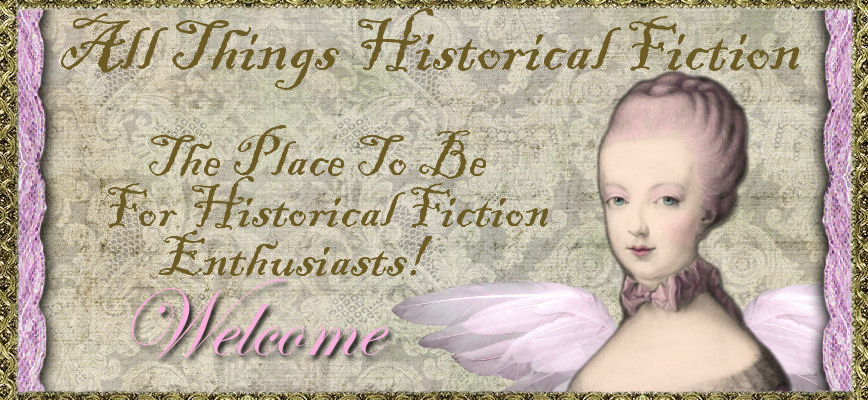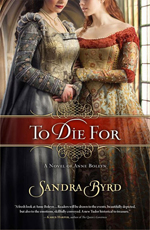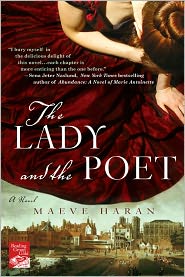1. What inspired you to tell the story of Anne Boleyn through the eyes of Meg Wyatt?
From a young age, we women are wired for friendship. Little girls link arms in exclusivity with one another on the playground. The most devastating betrayals during our middle and high school years often come not from boys but from the friends we thought loved us and in whom we'd trusted. So when I began to write novels set in the Tudor period I wondered, who were these Queens' real friends, those who would remain true in a treacherous court? Ovid wrote, "While you are fortunate you will number many friends, when the skies grow dark you will be alone."
2. There have been countless novels and non-fiction books based on the life of Anne Boleyn and her down fall. What drew you to tell her story once again and were you afraid To Die For would get lost amongst the other Anne Boleyn novels out there?
I believe the Tudor era is what the publishing industry refers to as "evergreen;" it never completely goes out of style. There are always new readers, and those readers who have read quite a bit of the era, like myself, are eager for a fresh take.
I think if it's the same story, retold the same way, it might be greeted with a yawn. But for me, as long as the point of view is fresh and I am captured by a new angle, I want to come along for the ride. I hope to provide that new angle and insight with each of my Ladies in Waiting books.
3. In the book Anne Boleyn and Meg Wyatt seemed to be the best of friends and would do anything for one another. Did this kindred friendship truly exist? Was there really a Meg Wyatt?
Yes, there was! My research journey took me to Meg Wyatt, narrator of my novel, To Die For. I will quickly note that in my book I have switched the names of the Wyatt daughters so that the eldest is named Anne/Alice and the younger Margaret/Meg so that the story could be told without two "Annes" to confuse the reader. It began, as all treasure hunts do, with one solitary clue, an offhand comment in a Tudorplace.com.ar link that said that Anne Wyatt attended Anne Boleyn till her death, and that, at the end, Anne Boleyn had given her friend her prayer book, a very personal gift indeed, and just before her execution whispered something in her friend's ear. The Wyatt family is ancient and is able to be traced back many centuries before our story picks up with Henry Wyatt, father of my heroine Meg and her siblings, including poet Sir Thomas.
4. My next question kind of goes along with the last question. How much of To Die For is based on historical fact and do you ever find it hard to stay true to those facts while also trying to entertain your readers?
There are a lot of different kinds of historical readers and writers, and each has their own preferences. My personal preference is to stick as close to as many known historical facts as possible, and then spin the fiction around those markers. I stuck with as much of Meg's life (as well as Anne's life) as I could find, and then fictionalized the rest. I tried, however, to make sure that all of the fiction "could" have happened, that is, it was true to the times. History itself is entertaining! It's the author's task to present and package it in a way that holds the reader's attention.
4. There is an abundance of information out there on Anne Boleyn and the rise of the Tudor court. How did you conduct your research for To Die For? Did you do anything differently in order to insure your novel would stand out amongst the rest?
I did what I imagine most or all historical novelists do, go to primary sources, read as much nonfiction on the subjects as possible, and visit as many sites as I could. I also avoided reading any fiction set in the era during my planning and writing phases, so as not to be influenced by someone else's fictional conjectures. I think my ace in the hole, though, was that I engaged a wonderful historical researcher named Lauren Mackay who works with novelists among other talents.
A flat document or a biography can't tell you if a plot twist is appropriate for the era, nor help you make corrections in titles, styles, language, or clothing, but a historical researcher can. Lauren can help field odd questions and has invariably read more in the period than I have by nature of her academic background.
5. Where do you do your best writing?
In my office. I have a framed print of Hever Castle, and the Six Wives, and a large contemporary portrait of Elizabeth I. I slip on my over the ear headphones and off I go. I corresponded this year with historian Christopher Gidlow who has an office in the Tower of London. I admit to a little envy!
6. I learned from your website that you have delved into many different genres of writing such as Teen, Adult, and nonfiction. Which genre do you enjoy writing in most? Do you think that by being able to write in different genres has made you a better writer/author?
I like writing in them all. I don't know whether or not it makes me a better author to write in many genres, but it does help keep me interested. When I am glutted of one approach, the other beckons. And then when I finish that project, I might switch to another genre. I think the most important thing that makes people better authors is to read, write, and continue to be well edited.
7. Who is your favorite historical figure…man or woman and why?
In this era, the ones I admire the most were those who courageously, but gracefully, stuck to their principals. They would include William Tyndale, Thomas More, Katherine of Aragon and of course, Anne Boleyn and Kateryn Parr. John Rogers, Meg's nephew, would die during Mary Tudor's reign. I admire Anne Askew; she appears in my next book. And of course, I love Elizabeth I.
8. Last but not least, what can readers expect from you next?
There will be two more books in the Ladies in Waiting series. The second book, The Secret Keeper, takes place during the queenship of Kateryn Parr. She was a strong woman, given to the reformation, and a best-selling author. But she had a soft spot for a bad boy and it led her, and those under her care, into trouble and distress. I hope readers will find a deep, witty, and nuanced Parr in this book with perhaps a surprise ending.
The third book in the series will take place in the court of Elizabeth, and will be told from the point of view of one of her ladies. We often hear about Gloriana, her power and amazing intellect, but not as often about Elizabeth's softer side as it intersected with her friends and her loves. Elizabeth was loyal but could also be a tempestuous friend, which made being her lady in waiting a bit of a balance walk and dangerous in its own right.


SYNOPSIS
What would you sacrifice for your best friend? Would you die for her?
Meg Wyatt has been Anne Boleyn's closest friend ever since they grew up together on neighboring manors in Kent. So when twenty-five-year-old Anne's star begins to ascend, of course she takes Meg along for the ride.
Life in the court of Henry VIII is thrilling...at first. Meg is made mistress of Anne's wardrobe, and she enjoys the spoils of this privileged orbit and uses her influence for good. She is young and beautiful and in favor; everyone at court assumes that being close to her is being close to Anne.
But favor is fickle and envy is often laced with venom. As Anne falls, so does Meg, and it becomes nearly impossible for her to discern ally from enemy. Suddenly life's unwelcome surprises rub against court's sheen to reveal the tarnished brass of false affections and the bona fide gold of those are true. Both Anne and Meg may lose everything. When your best friend is married to fearsome Henry VIII, you may soon find yourself not only friendless but headless as well.
A rich alchemy of fact and fiction, To Die For chronicles the glittering court life, the sweeping romance, and the heartbreaking fall from grace of a forsaken queen and Meg, her closest companion, who was forgotten by the ages but who is destined to live on in our hearts forever.
I have one copy of Sandra Byrd's book To Die For up for grabs! This giveaway is open to the US, UK, CAN, AUS and NZ! It ends September 7th at 12:00 a.m.
Giveaway Guidelines:
-You must be a Follower of this blog through the GFC follower in order to be entered into this giveaway.
-Please leave your name and email address in order for me to contact you if you are the winner. If an email is not listed then unfortunately you will not be entered.
+1 extra entry for being a new follower of this blog.
+1 extra entry each time you post this giveaway on twitter, facebook and/or on your blog somewhere. To count please leave a link in the comment section.












